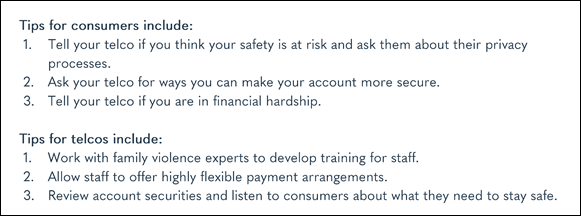
Issue No 37: 16 December 2020
Telecommunications Industry Welcomes Work to Support Consumers Impacted by Family Violence
The telecommunications industry welcomes the Telecommunications Industry Ombudsman’s publication of their research into assisting consumers impacted by family violence.
“Family violence impacts far too many Australians, and all industries and individuals have a role to play to help keep people safe. Telecommunications services are vital to keeping people connected, and there are steps telcos can take to support consumers,” said Communications Alliance CEO John Stanton.
“In 2018, Communications Alliance published the Assisting Consumers Experiencing Domestic and Family Violence Guideline, and we are currently working with industry and consumer advocates to update and expand that Guideline. The work the TIO has done in this space is valuable and the recommendations they have made align closely with the improvements we are making to our Guideline.”
The Guideline includes recommendations on staff training, changing account procedures to increase safety, and assisting customers experiencing financial hardship, among others. It prioritises empowering consumers by informing them of their options and checking with them how they wish to proceed, as every circumstance is unique.
“Many telcos have gone above and beyond developing staff training and innovative processes to support impacted consumers and keep them safe, and we are working across the industry to ensure all telcos are enabled to put the right systems, processes and training in place to help consumers,” Mr Stanton said.
“Along with the TIO, we emphasise the importance for telcos to prioritise a consumer’s safety at all times,” Mr Stanton concluded.
The TIO’s report included the following tips for consumers and telcos, which Communications Alliance supports:

If you need support because you or someone you know is experiencing family violence, call 1800 RESPECT. You can also find resources about technology safety and technology facilitated abuse at https://techsafety.org.au or at the eSafety Commissioner’s website: Domestic and family violence | eSafety Commissioner.
5G to Transform the 'New Normal' Post Covid-19
“This article by CEO AMTA, Chris Althaus, appeared in CommsWire on 9 December 2020”
Chris Althaus, CEO of AMTA, the Australian Mobile Telecommunications Association notes that 2021 has been touted as the ‘Year of 5G’, with mobile telecommunications through the 4G/5G ecosystem to continue providing all important connectivity, applications & services that will help enable Australia to recover from the COVID-19 pandemic.
Australia is currently a global leader in mobile connectivity after being named the number one nation in the world by the GSMA Mobile Connectivity Index for the sixth consecutive year. The ongoing rollout of 5G reflects our advanced mobile sector which gives Australians world leading mobile networks, services, and value for money.
The latest generation of mobile - 5G - will support advanced network performance, which is essential to drive increases in productivity and connectivity throughout our economy and society - particularly as we all transition to a ‘new normal’ post COVID-19.
5G is forecast to add up to $2,000 in gross domestic product per person after the first decade of the rollout. This potential GDP uplift makes it even more important that industry and governments work together on a joint focus to ensure a smooth and efficient evolution of 5G – to maximise the early adopter advantages particularly in commercial and industrial contexts. Simply, the sooner 5G can be deployed, the sooner these significant benefits will flow.
The Government has recently confirmed its commitment to embracing and supporting 5G via its $30 million investment announced in the 2020-21 Budget, including the establishment of the 5G Innovation Initiative, as well as its supportive response to recommendations of the 5G Inquiry. These are positive steps towards realising the 5G opportunity as a key part of Australia’s economic future and immediate COVID-19 recovery strategy.
With network operators already investing heavily in 5G infrastructure and accelerating network deployment, combined with the Government’s new investment, and the allocation of high and low band 5G spectrum in 2021, key pieces in the 5G jigsaw are being brought together at the right time and will be the platform for the full range of transformative benefits on offer through 5G.
The role of 5G in the ‘new normal’ world
The COVID-19 pandemic has seen enormous growth in demand for online access as a critical prerequisite for enabling us to stay connected personally and professionally. For example, the way we adapted to work, learn, and interact during lock-down relied mainly on internet access provided by fixed and/or mobile networks. (continued on next page)
Looking forward, the speed, capacity, and reliability that 5G offers will likely see greater flexibility and opportunity for our workforce to remain more geographically dispersed. One of the innovations of 5G - network slicing – enables bespoke connectivity that can be tailored to improve efficiency for enterprises and all sectors of our economy.
Companies will attract the best talent, regardless of location via virtual workplace connections. In the ‘new normal’, work and school will shift to be more of something you do, not necessarily dependant on somewhere you go.
The rollout of 5G, will also support an influx of 5G enabled technologies and innovations, which will not only boost productivity and drive digital transformation but bring new job opportunities.
During COVID lockdowns across the world, we saw many new examples of mobile technology use and innovation, with cellular connection enabling unmanned aerial vehicles (UAVs) or ‘drones’ to be used around the world to deliver test samples and much needed medical supplies, conduct temperature checks, disinfect public places, and broadcast safety announcements.
Drones have also been used to deliver food and consumer items when lockdown kept residents confined to their homes. Through 5G, drones could become more commonplace and used widely by Australian industries and businesses, unlocking jobs and even greater opportunities within the convergence of industry and smart ubiquitous mobile and fixed technologies.
The low latency and capacity of 5G networks means cloud computing and IoT technology will also improve, becoming faster and allowing devices, applications, and services to connect and perform their tasks in real-time if necessary, with full mobility.
Invigorating Australian industry
The Australian Government has recently announced that it will invest $22.1 million to establish the Australian 5G Innovation Initiative to run 5G commercial trials and testbeds in key industry sectors such as agriculture, mining, logistics and manufacturing. With the right partnerships with mobile network operators, this initiative has great potential to be an important catalyst for innovation and deeper deployment of 5G, which will invigorate industries and enterprises.
5G will be central to manufacturing processes – driving efficiencies through data analytics, artificial intelligence with IoT systems and automation based on intelligent connectivity, opening up the possibility of new or reborn industries.
5G and IoT advancements will also fuel the growth of smart cities, homes and vehicles in Australia, helping to transform our living environment through management and utilization efficiencies across transport, energy, water, climate, health - the list goes on. Put simply there will not be a sector untouched by this agenda - so often called the 4th industrial revolution.
Another Australian industry that will be boosted by 5G is agriculture. The capacity, high speeds, and reliability of 5G in regional centres will see possibilities of smart farming and precision agriculture with significant efficiencies to be gained as we meet local and global food demand.
The health sector will also benefit from 5G. While tele-health and remote medicine is not a new idea, 5G will support critical medical innovations through remote access, real time monitoring and precision medical intervention supported by 5G network capacity and ultra-low latency.
There are already excellent examples of key medical research groups testing 5G enabled medical technology, including the Ingham Institute for Applied Medical Research in Sydney that is currently assessing a remote-controlled robot that could potentially remove blood clots in stroke patients, and the King’s College in London in partnership with Ericsson that is trialling specialised haptic feedback gloves and virtual reality (VR) equipment to be able to operate on a patient via a robotic counterpart, potentially thousands of miles away.
5G connectivity will also likely see the growth of augmented and virtual reality technologies in other industries, such as the education and events sector, allowing them to harness immersive technology to deliver more interactive content and drive engagement.
It is through industry developments such as these that the impact of 5G will begin to be felt across the full spectrum of industries and the economy as a whole, as Australia and countries around the globe seek to navigate their way back from the devastating economic and social impacts of the COVID-19 pandemic.
The importance of public confidence
As the demand for reliable connectivity and data services escalates, and the presence of 5G becomes more mainstream, it’s likely there will be some concerns for some people. The Australian mobile telecommunications industry takes very seriously our responsibility to provide information from expert medical agencies and standards organisations who address all health and safety aspects related to the roll out of 5G.
This includes providing information from bodies such as the World Health Organisation (WHO) and Australian Radiation Protection and Nuclear Safety Agency (ARPANSA), which base their advice on decades of scientific research.
According to ARPANSA, there is no established evidence that low level radio wave exposure from 5G and other wireless telecommunications can affect the immune system or cause any other long-term or short-term health effects. The Government’s response to the recent
Australian Parliamentary Inquiry into 5G also highlights this conclusion, explicitly stating ‘the higher frequency waves [used for 5G], have been extensively researched and are not hazardous to human health’.
As we continue to see the 5G ecosystem mature, the mobile telecommunications industry and government are committed to working together to further build public awareness and understanding of 5G through research and education. This will be extremely important in growing public confidence and trust in 5G.
The COVID-19 pandemic has shown us just how critical online connectivity is to how we live, work, learn and socialise. Now as we look to the future, 5G will be equally critical to ensure our recovery and progress in the ‘new-normal’ is as successful as possible.
Season’s Greetings and Best Wishes for the New Year
| This is the last issue of We Communicate for 2020. Thank you to all our members for your support, guidance and contributions to our work during 2020. We look forward to another creative, constructive and successful year of working together and in your service. |
Feedback | Contact Tel: (61) 2 9959 9111 |

